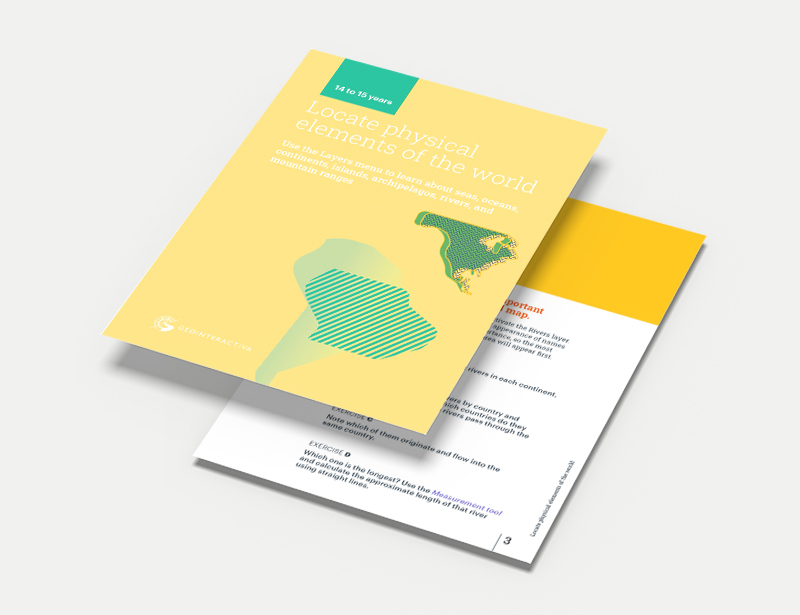
secondary (14-15 years).
The physical elements of our planet.
In this activity, you will learn about the physical elements that make up our planet, such as continents, oceans, mountains, rivers, lakes, islands, archipelagos, and more. In this article, we will explore the importance of knowing these physical elements and how they relate to each other.
In this downloadable resource, you will find a PDF with instructions to liven up your classes. On one hand, we show you which platform tool you will work with, and on the other hand, we offer activities suitable for 14-15-year-old students.
Do you want your classes to be stimulating? Start today with Geointeractive.
we suggest teaching geography in a fun way
What will your students learn from this educational activity?
The physical elements of our planet
Geography is the science that studies the world we live in. One of the main objectives of geography is to understand and comprehend the physical elements that make up our planet, such as continents, oceans, mountains, rivers, lakes, islands, archipelagos, and others. In this article, we will explore the importance of knowing these physical elements and how they relate to each other.
Continents
Continents are large land masses that are separated by oceans. There are six continents: America, Europe, Asia, Africa, Oceania, and Antarctica. Each of them has its own geography, climate, flora, fauna, and culture. Continents are important because they define the geographical distribution of the world’s population and are fundamental to trade and international relations.
Oceans
Oceans are large bodies of saltwater that cover most of the Earth’s surface. There are five oceans: Atlantic, Pacific, Indian, Arctic, and Antarctic. Oceans are vital to life on Earth as they regulate climate and weather, provide food and natural resources, and are crucial for transportation and trade.
Mountains
Mountains are large elevations of land that rise above the surrounding terrain. Mountains are important because they play a key role in regulating climate, as they influence wind and precipitation patterns. Additionally, mountains are home to a variety of flora and fauna and provide natural resources such as water, minerals, and timber.
Rivers
Rivers are streams of water that flow into another river, lake, or the sea. Rivers are important because they are a vital source of freshwater and are essential for agriculture, hydroelectric power generation, transportation, and tourism. Moreover, rivers are home to a diverse range of aquatic life and are a key component of riparian ecosystems.
Lakes
Lakes are bodies of freshwater or saltwater, generally smaller than seas, that are surrounded by land. Lakes are important because they are a source of freshwater for human consumption, agriculture, and industry. Additionally, lakes are a vital component of aquatic ecosystems and provide habitats for aquatic life.
Islands and Archipelagos
Islands are lands surrounded by water on all sides, while archipelagos are groups of islands. Some of the most famous islands and archipelagos include Hawaii, the Galapagos Islands, the Falkland Islands, and the Canary Islands. Islands are important because they have unique geography and biodiversity and are a significant tourist destination.
The importance of knowing the world’s major physical elements
It is important for students to know the world’s major physical elements and learn how to locate them on a map. This will help them understand how the world around them works and how different elements interact with each other. It will also allow them to gain a deeper understanding of geography, which in turn will help them better understand the economy, culture, and history of different regions.
Conclusions
Knowing the world’s physical elements is important because it has practical implications in daily life. For example, natural resources such as water and forests are closely related to physical geography. Also, natural disasters such as earthquakes, tsunamis, and volcanic eruptions can have a significant impact on people’s lives, and their knowledge can be vital in preventing and mitigating their consequences.